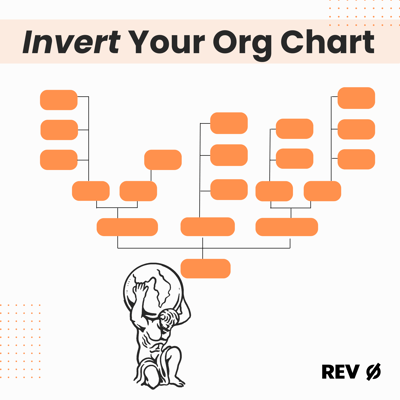We're all familiar with the traditional organization chart - the CEO at the top and the rest of the organization cascading down below. But what if we flipped that chart upside down?
How would it change our perception of our roles and leadership within the organization?

Our primary role as leaders is to support and empower those "above us" in the inverted org chart.
When we see the org chart as a model of support, the heaviest load is upon the shoulders of the directors and CEOs. But this new view doesn't just affect those at the bottom; it impacts every layer of management.
Every leader must ask themselves:
-
- Are we equipping our layers of management to take care of those in their charge?
- Is our leadership team working together to strengthen the foundation?
- Are we taking care of ourselves so that we can continue to support the organization?
- Who is overloaded?
- Where do we need more support?
This shift in perspective and subsequent line of questioning tends to resonate with those who embody servant leadership values. For everyone, though, it can significantly change how we approach everything from hiring, promotions, layoffs, and change initiatives.
For example, related to promotions, instead of asking, "Who deserves a promotion?," we start asking, "Who is ready to carry more?"
Management roles act as support structures.
Hierarchies naturally form when people come together in any concerted effort—projects, sports, business, clubs, and even family. They tend to emerge even in groups that deliberately set out not to have a hierarchy. For example, in a volunteer organization or a startup, the people at the "top" of the org chart are simply those who are willing to take on the most responsibility or risk. It's not an attempt to control but an attempt to help and bring stability.
If we let go of the idea of control, invert our org charts, and look at them from the perspective of support, what do we see? How does our understanding of our roles change?
Embrace a "chief" mindset.
There will always be bad actors and people who abuse control, but even more who don't.
For every dictatorial leader, there are a hundred protective leaders. CEOs can embrace the "Chief" part of their title by looking to the great chiefs throughout history—leaders who put the good of their people ahead of their own ambitions, whose names we may not remember, but whose legacy lives on.
Middle managers play a crucial role in translating this servant leadership mindset into practical action by boldly advocating for the support needed from their leaders and using those resources to better serve the team. By securing the support needed, middle managers are better equipped to serve as a strong foundation for those in their charge.
Invert your org chart to transform leadership and support others within your organization.
A small shift in perspective can have a profound effect. While there is rightly dissatisfaction with org charts, much of that is rooted in misunderstanding and misuse. Just because something doesn't work doesn't mean it needs to be dismantled or deconstructed; sometimes, we just need to view it from a different angle.